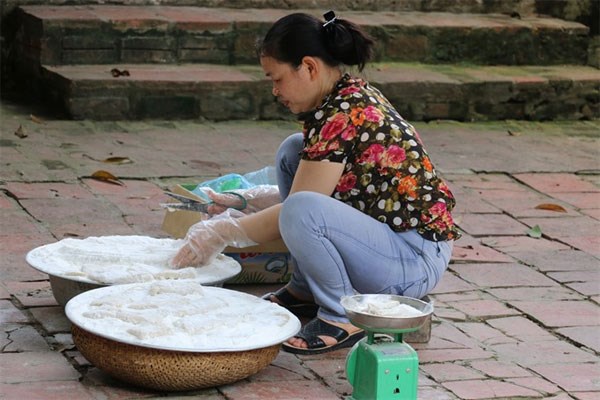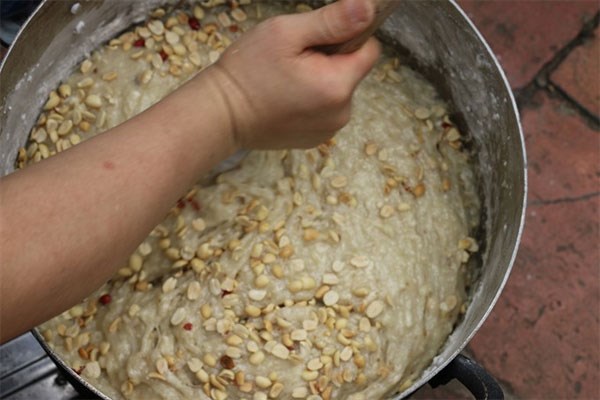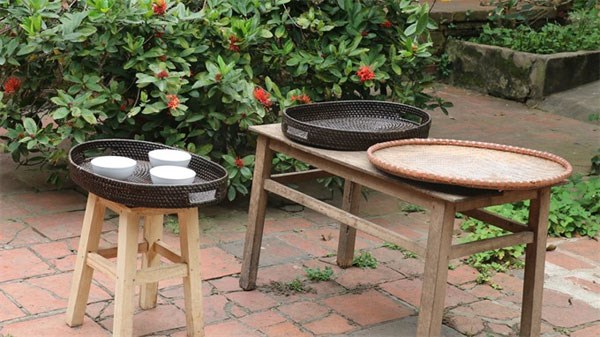
Handmade: After cooking, Ha Thi Thuy spreads che lam on a bed of roasted glutious powder to cool down.
Duong
Lam is one of the few villages left intact from the Middle Ages in the Red
River Delta. The old houses, built with laterite bricks, have remained
virtually unchanged over the years. The oldest house in the village has been
said to be around 400 year old.
The
residents are used to having strangers coming into their houses, asking
questions about not only the village, but also its crafts and history, and
later having lunch prepared by the family or even staying over night.
For
our one-day trip, the main concern was to book a decent lunch the group and,
most importantly, learn to make che lam.
The
ancient houses in Duong Lam belong to big families and they are used to having
big family get-togethers a few times a year. But over time, as Duong Lam became
a popular attraction not only with international tourists, but also local
school children and independent travellers, these families have geared
themselves to host big parties more often.
But
the most popular request is still providing lunch for tourists.
Duong
Lam boasts quite a few delicacies: charcoal roasted pork, mia chicken - small
in size but quite plump and juicy, and homemade soy sauce for fish stew or
vegetable dips.
All
we wanted was some boiled chicken chops, boiled vegetables, a well done and
seasoned fried egg and some rice. But since this would not be worth their
while, we decided to order food by tray at VND600,000 (US$26), which has a
little bit of everything including roasted pork, fried nem, boiled tofu, boiled
chicken, a stir-fried dish and last but not least, the fish stew.
Before
we set out to go to the village, I’d already called Duong Lan, a descendant of
Duong, a famed scholar. Lan had agreed to prepare ingredients for us to learn
how to make che lam, a local treat that every housewife can make, but one for
which each family has a secret recipe.
I’d
had lunch at Duong Lan’s place last year with my children and the che lam
served for dessert was so good I wanted to learn to make it, and she agreed to
teach me.
"Yes,
come here, I’ll get the ingredients ready for you, but you need to take the
whole thing when finished," she said on the phone. This would mean three
kilos of finished che lam bars.
To
make three kilos of che lam, you need as many kilos of glutinous rice which is
roasted until it pops (like popcorn) and ground a couple of times to get a fine
flour. Two kilos of normal rice is also roasted and ground to get a soft
powder. 200g of peanuts are roasted in a pan until golden brown, shelled and
placed in a bowl.
200-300g
of ginger (the older the better, according to Lan), unpeeled, is pounded. This
is mixed well in six rice bowls of water, each bowl for half a kilo of sticky
rice powder. In short, boil 1.5 litres of water with the pounded ginger and add
1.8-2 kilos of sugar, depending on your sweet tooth.
The
most demanding technique in making che lam is the stirring. When the ginger
sugar mix boils, the heat is turned off. The three kilos of glutinous rice
powder is added, stirring slowly in the same direction. It seems simple at
first, but using only one big bamboo stick to stir the 3 kilos of glutinous
rice requires strong arms. Next, the peanut is added and stirred well
again. The heat is turned back on and
the mixture is brought to boil. This is then taken off the stove and poured on
to two big tray with the normal rice flour.
The
next part is both fun and a bit dangerous. More flour is added on top and you
should keep stirring so that it cools down and won’t get too sticky. It looks
fun, but be aware, it’s burning hot and I suggest you don’t let your children
play near it until it cools down. After a couple of hours, the trays cool down
and you can start cutting it into free-size bits mixed well with rice powder,
or into neat rectangles that can be sliced later into bars. Either way it looks
good and tastes best when consumed with a cup of fresh green tea.
Visitors
can go to Duong Lan’s house and ask her to help get each ingredient for this
desert. She doesn’t have sticky rice powder ready at hand, but she said she’s
willing to walk people through each step of the way.
It
was quite an experience for us, sitting in the big yard of her ancient house
under the old fruit trees and very old coffee plants (belonging to the Rubiaceae
family) in full bloom. It felt we’d traveled back in time.
Lan
reminisced: "One of the most memorable times for me here was when I taught
a group of Japanese high school students how to make che lam on a full moon
autumn night," she said. "They were very courteous and keen to learn,
they read and chatted, and it was very peaceful."

Strong-armed: Stirring the che lam mixture, especially when making several kilos, requires strong arms.

Table is set: All the ingredients need to be at hand.

Made for each other: Che lam tastes best with fresh green tea. — Photos: Hong Van/VNS
By VNS